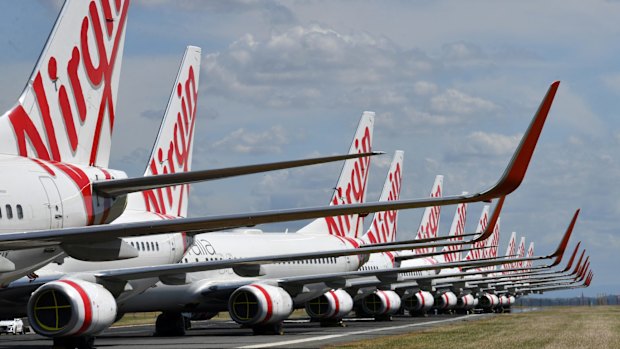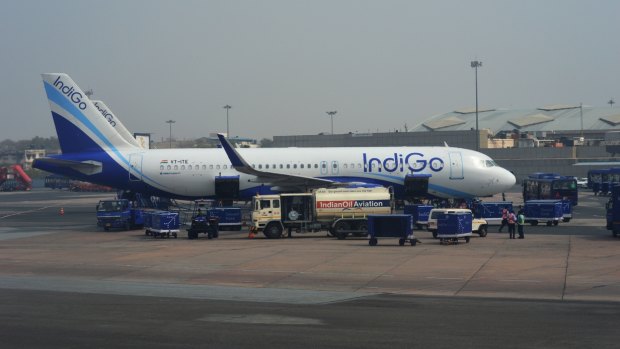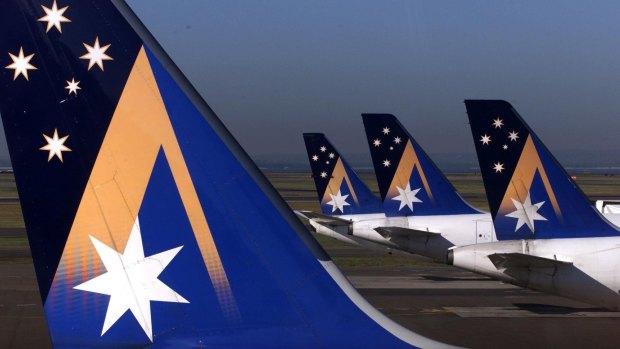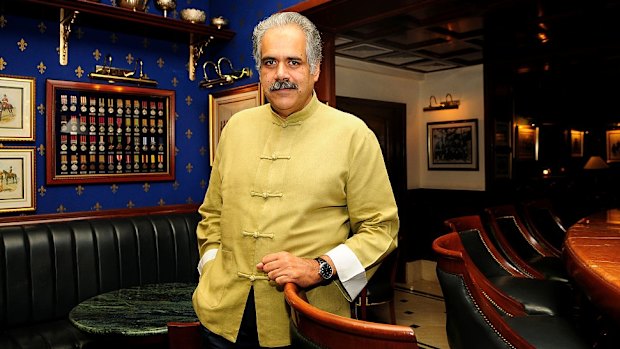This was published 3 years ago
Airlines and coronavirus: The suprising airline magnate considering a bid for Virgin Australia
By David Fickling

Grounded Virgin Australia aircraft parked at Brisbane Airport.Credit: Darren England
What do you get for the airline magnate who has everything? If he knows what's best for him, the answer isn't "another airline."
Rahul Bhatia, the biggest shareholder in India's biggest carrier, InterGlobe, is evaluating data and considering a bid for Virgin Australia, a person familiar with the matter told Anurag Kotoky and Angus Whitley of Bloomberg News. He would bid via the vehicle he uses to invest in IndiGo, as India's biggest budget airline is known, the person said.
It's not hard to see the attractions. IndiGo's home market is fiercely competitive, with half a dozen major carriers duking it out even after Jet Airways was forced into bankruptcy last year. Jet was squeezed between the loss-making full-service flights offered by state-owned Air India and IndiGo's own devastatingly cheap fares. Australia, on the other hand, is more or less a duopoly between Virgin Australia - which was itself put into a coronavirus-induced administration last month - and a dominant Qantas. That should offer the opportunity for the two carriers to cozily carve up the market between themselves.

Credit: iStock
Opportunities to break into the Australian airline game don't come along often. The last time was when Ansett collapsed just days after the September 11 attacks. A fledgling Virgin Australia, at the time a budget carrier named Virgin Blue, was perfectly placed to capitalise.
Despite the vast disparity in population, Australia isn't that much smaller than India as a market, thanks to greater wealth and a higher propensity to fly. Traffic last year came to about 71 billion revenue passenger kilometres, roughly the size of the fast-growing Indian aviation market five years ago.

Credit: Dallas Kilponen
It also has close links to India, raising the prospect that an Australian network could feed passengers via international flights into IndiGo's domestic web of destinations. Indian-Australians make up close to 2 per cent of the population, and the number of non-resident Indians - the subset of the diaspora who are most likely to take regular flights back to the motherland - is the largest after the UK, US, Singapore, Nepal, and the Persian Gulf countries.
For all that, Bhatia should pass up the chance to have a crack at Virgin Australia. In its ruthless efficiency in controlling its home turf, Qantas behaves a lot like IndiGo, one reason that Australia has for a decade been a graveyard for ambitious foreign airlines. His best opportunities lie closer to home.

Credit: Getty Images
Both Qantas and IndiGo exploit a rare and priceless phenomenon known as the S-curve, by which dominant airlines end up with more connections and a greater share of traffic the more planes they add. That makes life extremely difficult for competitors.
Singapore's attempt to set up a bridgehead via an outpost of its budget carrier Tiger Airways ended up being sold to Virgin Australia back in 2014 at a valuation of $A2.50, after years of struggle. AirAsia showed fitful interest in establishing a bigger presence Down Under, but ended up mostly steering clear.
Virgin Australia itself spent years trying to break the Flying Kangaroo's dominance with the backing of strategic overseas players. Ordinary shareholders hold less than 10 per cent of the now-worthless stock, with the balance being held by a rotating cast of carriers including Etihad, Singapore Airlines, Hainan Airlines, Qingdao Airlines, Air New Zealand, and Richard Branson's Virgin Group itself. Their indifference to profits enabled Virgin to compete against Qantas for longer than many would have thought possible, but it hasn't been enough to win the battle.
The distance between Australia and India is too great to make connecting the two markets an easy play, too. IndiGo's aircraft of choice is the Airbus SE A320neo, which some budget carriers have been using to open up longer-range routes -but it would be operating at its limits even on flights between India and Perth, which is a long way from Australia's more populous east coast. That would necessitate Bhatia either using an unfriendly hub airport in Southeast Asia, or investing in bigger, more expensive twin-aisle jets.
IndiGo is so powerful in its home market that it's natural its owners should be looking at overseas expansion - but as we've argued, the better place for that is in the Persian Gulf, where a far bigger Indian diaspora is closer to home and largely flown across the Arabian Sea on Gulf carriers such as Emirates.
With a pandemic-induced passenger drought threatening most non-state-backed players in the global aviation market, this is no time for Bhatia to go planting seeds in Australia's barren soil.
BLOOMBERG
Sign up for the Traveller newsletter
The latest travel news, tips and inspiration delivered to your inbox. Sign up now.